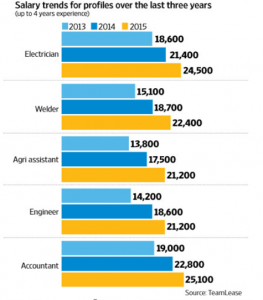With Growing Linkage to Higher Education Can an Apprenticeship Become a Preferred Career Option? Or Even a Substitute for Higher Education?
While India embarks on an ambitious apprenticeship plan, a conventional higher education qualification is not the only career path. Jobs need skills not qualifications.
The case for adopting a nationwide apprenticeship programme by Indian industry, training institutes and colleges has never been stronger. The BJP-led NDA government launched The National Apprenticeship Promotion Scheme (NAPS) 2016 with a vision to train 50 lakh apprentices by 2022. There have been significant initiatives and important changes to the Apprentice Act 1961 to augment talent pool from the bottom up to help Indian youth become job worthy and relevant to market demand.
In a country with an annual turnout of an estimated 3.5 lakh engineers and 2.5 million university graduates, and where an estimated 5 million graduates are out of work at any given point, what is the value of an apprenticeship and what role should higher education play?
Shop Floors as Classrooms
According to a 2016 survey by the Annual States of Education Report (ASER)1 as many as 4.6% of 11-14 year olds were registered as drop-outs or never enrolled on the day an ASER team visited the school. This figure rose to 15.3% for children aged 15-16 years. The primary reasons for the drop-out rates were a lack of interest in the curriculum and poor reading and arithmetic skills in these children. So what choice do these youth, who could be struggling with a purely academic curriculum, have to better their lives and contribute to the country’s economy? Is there a gap where they could fit perfectly?
This is where the learning-by-doing and learning while-earning mantra can build a skilled young workforce to meet the enormous shortage of job-ready talent in industries ranging from manufacturing to retail, automobile to construction, sales to IT-enabled services, healthcare to engineering, to name a few.
Case in point- In December 2016, largely due to its model apprenticeship programme only 6.7% of 15-24-year olds in Germany were without a job, compared with 17.3 per cent across EU member states2. In the UK, according to the Centre for Economics and Business Research (CEBR) apprenticeships contributed £34 billion to the UK economy in 2014, a cost benefit ratio of £1 to £21 of public money to the national economy3.
The Wheels Are Turning
The Apprentice Act 1961 has undergone massive amendment in 2014 from being restrictive and prescriptive to allowing both youth and employers with more options to develop the skills necessary to become productive. The government has taken several positive steps to ease the way to scale up apprenticeships in India. Let’s look at some of them.
Substitute for Traditional Higher Education
Apprenticeship Degree Courses
Recognised by the University Grants Commission of India (UGC), the Bachelor of Vocational Studies, B.Voc4. is a three-year degree programme which aims to align higher education with skills demand in different industries. This is a welcome step away from a set theoretical curriculum to a more practical (40% theory and 60% practical) hands-on education that addresses current and future employability trends. This course is built on industry participation as the curriculum grooms students to be highly employable through a unique blend of vocational and entrepreneurship concepts.
It has multiple options:
- Diploma (after 1 year)
- Advance Diploma (after 2 years)
- B.Voc degree (after 3 years)
- M.Voc degree (Master’s after a B.Voc)
With many specialisations available in B.Voc.- software development, textile design, apparel manufacturing & entrepreneurship, fashion design & retail; web technologies & multimedia, digital art & animation, printing & publishing, to name a few, the B.Voc is an excellent step towards elemental vocational training in the country.
National Apprenticeship Training Scheme (NATS)5
- Imparts vocational training to fresh graduates, diploma holders and 10+2 vocational pass-outs.
- Pan India implementation of the scheme in 126 subject fields in over 13,000 industries in over 2000 central, state and private industrial establishments and training institutes.
- Students enroll for a year under trained managers and emerge technically qualified and ready to join the workforce
- Successful apprentices are awarded a Certificate of Proficiency by the government which is recognised by all employment exchanges as valid employment experience.
Wide choice of categories:
- Trade apprentice – eligibility 8th, 10th, 12th standard and Industrial Training Institutes (ITIS) pass-outs
- Graduate apprentice- eligibility, any degree holder
- Technician apprentices – eligibility, any diploma holder
- Technician (vocational) apprentice- eligibility, a vocational training certificate by the All India Council
- Optional trade apprentice- industry free to design a course pertaining to their niche requirements
Additionally:
- Trainees under dual-learning mode – Government and private ITIS offer training programmes in high employability courses to match industry demand
- Trainees who have completed Pradhan Mantri Kaushal Vikas Yojna (PMKVY) courses
- Apprentices who are not covered under NATS administered by MHRD
Watch how Dinesh Kumar benefitted from PMKVY @MSDESkillIndia
Fast-track careers
Monthly government stipend rates paid to the different categories of apprentices ranges from Rs. 2758 to Rs. 49846. Employers are free to pay above this minimum wage. Most interestingly, a TeamLease Services7 report which looked at three years’ worth of data across job portals and its own internal database found that the salary of a vocational degree blue collar worker across 12 sectors exceeded those of engineers anywhere between 10% and 27%. Additionally, salaries were at the same level as MBA holders in six out of the 12 sectors studied (see footnote).8


To add to this extremely encouraging data, an advanced pattern maker in a factory who was earning Rs. 20,000 in 2015 has the potential to reach Rs. 55,000 in eight years. Similarly, an electrician in an electronics company reached Rs. 54,900 with eight years of experience which represents 4% more than what an engineer in the same industry was earning with the same experience.7
For many youngsters, especially from smaller towns and the rural hinterland an apprenticeship can therefore become a life changing career option, a preferred opportunity, even a substitute for higher education.
Conclusion
A higher wage premium and steady job prospects compared to unskilled peers are significant motivators to go down the apprenticeship route. As the apprenticeship system gains momentum as a valued profession, choices are opening up for millions of youth to plan their futures. They may choose a higher education apprenticeship degree or from the many other alternative apprenticeship routes. For school drop-outs or the not so academically inclined having an apprenticeship provides an option to turn their lives around, gaining the skills and the confidence to aspire to bigger and better things.
——————————————————————————————————-
References:
1Annual States of Education Report (Rural), 2016
2Germany’s apprenticeship scheme success may be hard to replicate, Apr 2017, Financial Times
3Economic Impact of Apprenticeships, Nov 2014, Centre for Economics and Business Research
4Scope of B.Voc Course in India and Abroad, Jul 2018, ISRG Knowledge Base
5National Apprenticeship Training Scheme (NATS), MoHRD,
6Directorate General of Training, MoSDE
7When electricians earn more than engineers, Apr 2016, LiveMint
8Footnote– The engineering colleges considered for the study were ranked 50- plus in the Outlook engineering college rankings and MBA colleges 40-plus by Business Today B-school rankings.














